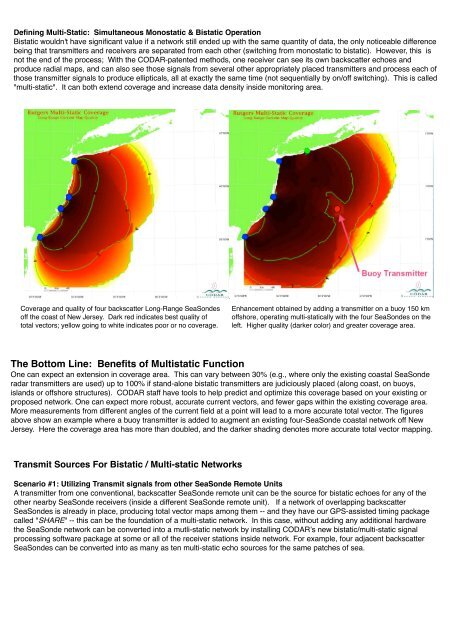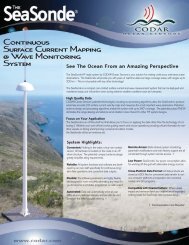SSonde_Cat_rev201003.. - CODAR Ocean Sensors
SSonde_Cat_rev201003.. - CODAR Ocean Sensors
SSonde_Cat_rev201003.. - CODAR Ocean Sensors
You also want an ePaper? Increase the reach of your titles
YUMPU automatically turns print PDFs into web optimized ePapers that Google loves.
Defining Multi-Static: Simultaneous Monostatic & Bistatic Operation<br />
Bistatic wouldn't have significant value if a network still ended up with the same quantity of data, the only noticeable difference<br />
being that transmitters and receivers are separated from each other (switching from monostatic to bistatic). However, this is<br />
not the end of the process; With the <strong>CODAR</strong>-patented methods, one receiver can see its own backscatter echoes and<br />
produce radial maps, and can also see those signals from several other appropriately placed transmitters and process each of<br />
those transmitter signals to produce ellipticals, all at exactly the same time (not sequentially by on/off switching). This is called<br />
"multi-static". It can both extend coverage and increase data density inside monitoring area.<br />
Coverage and quality of four backscatter Long-Range SeaSondes<br />
off the coast of New Jersey. Dark red indicates best quality of<br />
total vectors; yellow going to white indicates poor or no coverage.<br />
The Bottom Line: Benefits of Multistatic Function<br />
One can expect an extension in coverage area. This can vary between 30% (e.g., where only the existing coastal SeaSonde<br />
radar transmitters are used) up to 100% if stand-alone bistatic transmitters are judiciously placed (along coast, on buoys,<br />
islands or offshore structures). <strong>CODAR</strong> staff have tools to help predict and optimize this coverage based on your existing or<br />
proposed network. One can expect more robust, accurate current vectors, and fewer gaps within the existing coverage area.<br />
More measurements from different angles of the current field at a point will lead to a more accurate total vector. The figures<br />
above show an example where a buoy transmitter is added to augment an existing four-SeaSonde coastal network off New<br />
Jersey. Here the coverage area has more than doubled, and the darker shading denotes more accurate total vector mapping.<br />
Transmit Sources For Bistatic / Multi-static Networks<br />
Enhancement obtained by adding a transmitter on a buoy 150 km<br />
offshore, operating multi-statically with the four SeaSondes on the<br />
left. Higher quality (darker color) and greater coverage area.<br />
Scenario #1: Utilizing Transmit signals from other SeaSonde Remote Units<br />
A transmitter from one conventional, backscatter SeaSonde remote unit can be the source for bistatic echoes for any of the<br />
other nearby SeaSonde receivers (inside a different SeaSonde remote unit). If a network of overlapping backscatter<br />
SeaSondes is already in place, producing total vector maps among them -- and they have our GPS-assisted timing package<br />
called "SHARE" -- this can be the foundation of a multi-static network. In this case, without adding any additional hardware<br />
the SeaSonde network can be converted into a mutli-static network by installing <strong>CODAR</strong>ʼs new bistatic/multi-static signal<br />
processing software package at some or all of the receiver stations inside network. For example, four adjacent backscatter<br />
SeaSondes can be converted into as many as ten multi-static echo sources for the same patches of sea.




